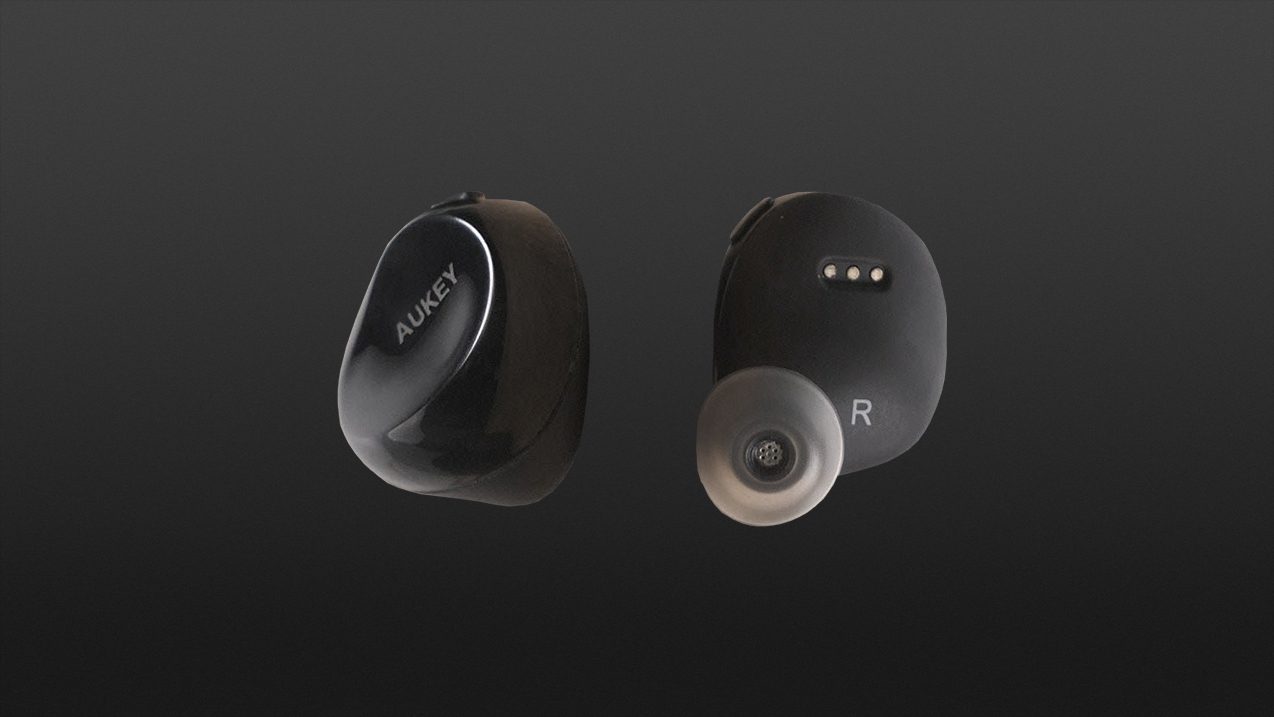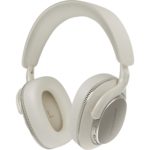The Aukey EP-T1 True Wireless delivers an acceptable but somewhat dull sound, unreliable Bluetooth pairing and earmolds that might prove an awkward fit. Replacement earmolds are therefore highly recommended. The running time is reasonable and the controls are well thought out, but the light display at the earpieces is rather superfluous in my opinion. Both the in-ears and the charging case are made of soft-touch material. I give the sound capabilities a passing grade, while the overall package is relatively satisfactory given the asking price of approximately 50 euros. Just don’t expect too much for that price.
True wireless in-ears for 50 euros? Aukey aims to prove this possible with the EP-T1, promising the best sound with the fullest bass, most stable of Bluetooth connections and impressive battery life. Is this possible?
What’s Included?
Typical of Aukey products, this tech comes in a brown cardboard box with simple printing. Inside there’s the charging station, the headphones, charging cable, earmolds and user documentation. First impressions are good, with the in-ears themselves and charging dock both looking robust, even if the paper-thin earmolds look a little delicate. On closer inspection, I failed to see much of a difference in size between the three sets of earmolds. Despite this, the earmolds offer a decent enough fit, although they leave a lot to be desired when it comes to sealing the auditory canal against external noise. I found myself constantly having to press against them to achieve any reasonable reduction in external noise and ensure audio playback was at least halfway undisturbed.
Pairing and Listening
To begin, pairing via Bluetooth 4.2 needs to be carried out for both earpieces in order for them to connect to each other. With voice announcements to guide you along, this process is easy. Due to the fact control buttons can be found on each earpiece, they can be used individually. When switching off, simply press one button to shut down both. Everything works rather smoothly and reliably, even if the stable Bluetooth connection promised in the advertising leaves something to be desired due to frequent stuttering. The connection is also prone to interruption. I only need to push my glasses with my hand or turn my head enough to one side to disrupt the signal.
With current chart music from the likes of David Guetta and Clean Bandit in the test playlist, another advertising promise falls short. Powerful sound with impressive depth is instead replaced by hardly any depth at all. The situation is most aptly described by an excess of mid-highs and a lack of bass, although a slight increase in bass can be achieved with the iPhone equaliser, leading to a somewhat more developed sound. In addition to this, by pressing the in-ears deeper into the ears, you can produce a reasonable stereo image with reasonable depth of sound, which would also prove loud enough if the EP-T1 didn’t have that niggling issue with those awkward earmolds.
All in all, I can give the sound capabilities of the EP-T1 a satisfactory pass. I am almost sure that better earmolds could provide a better sound performance. In addition, the in-ears could also do better when it comes to overall sound balance in order to score more highly.
A special mention should also be made of call functions, due to the fact that the EP-T1 is suitable for telephony with sufficient speech intelligibility, even if it’s not enough to raise the overall grade of these earphones. What’s more, you can only hear the called party via the left side.
Controls and Charging
Both sides of these in-ears have a button at the top which serves to control numerous functions and switching commands. A simple click on the left or right stops or starts music, while double clicks on the right increase volume, while clicks on the left decrease it. A longer left click serves to jump back, while a long right click jumps forward. This makes controlling the device incredibly easy.
The lighting in the form of flashing/pulsating Aukey lettering on the outer sides of the earbuds also work reliably, which is unnecessary in my eyes as it disturbs the otherwise stylish aesthetic of the device and the wearer doesn’t really get any benefit from the feature.
The supplied charging case extends the specified playing time of four hours by a factor of six for every two hours of charging time. It should also be noted that this solid case is not really suitable for carrying around, with the rubberised underside more at home sat atop a table than tucked into a trouser pocket.
Technical specifications
- Ear couplingIn-ear
- Typeclosed
- Transducer principledynamic
- Frequency response (headphones)20 - 20.000 Hz
- Impedance16 ohms
- Sound pressure level (SPL)93 dB ±3 dB
- Weight without cable10 g
What's in the box
- 3 pairs of ear-tips
- USB charging cable
- Charging case
Special features
- BT version: 4.2
- BT profiles: A2DP, AVRCP, HSP, HFP
- Weight charging case: 59g











































